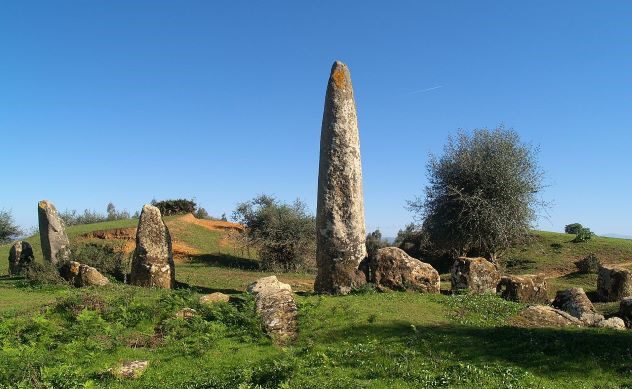 Weird Stuff
Weird Stuff  Weird Stuff
Weird Stuff  Our World
Our World 10 Ways Your Christmas Tree Is More Lit Than You Think
 Movies and TV
Movies and TV The 10 Coolest Stars to Set Sail on The Love Boat
 History
History 10 Things You Didn’t Know About the American National Anthem
 Technology
Technology Top 10 Everyday Tech Buzzwords That Hide a Darker Past
 Humans
Humans 10 Everyday Human Behaviors That Are Actually Survival Instincts
 Animals
Animals 10 Animals That Humiliated and Harmed Historical Leaders
 History
History 10 Most Influential Protests in Modern History
 Creepy
Creepy 10 More Representations of Death from Myth, Legend, and Folktale
 Technology
Technology 10 Scientific Breakthroughs of 2025 That’ll Change Everything
 Weird Stuff
Weird Stuff Ten Bizarre Facts About The Doge Meme
 Our World
Our World 10 Ways Your Christmas Tree Is More Lit Than You Think
 Movies and TV
Movies and TV The 10 Coolest Stars to Set Sail on The Love Boat
Who's Behind Listverse?

Jamie Frater
Head Editor
Jamie founded Listverse due to an insatiable desire to share fascinating, obscure, and bizarre facts. He has been a guest speaker on numerous national radio and television stations and is a five time published author.
More About Us History
History 10 Things You Didn’t Know About the American National Anthem
 Technology
Technology Top 10 Everyday Tech Buzzwords That Hide a Darker Past
 Humans
Humans 10 Everyday Human Behaviors That Are Actually Survival Instincts
 Animals
Animals 10 Animals That Humiliated and Harmed Historical Leaders
 History
History 10 Most Influential Protests in Modern History
 Creepy
Creepy 10 More Representations of Death from Myth, Legend, and Folktale
 Technology
Technology 10 Scientific Breakthroughs of 2025 That’ll Change Everything
10 Stone Age Mysteries
The Stone Age accounts for more than 98% of our known history, beginning at a very distant point some 2.6 million years ago and stretching to around 3000 BC. The era goes so far back that it encompasses multiple ice ages and the introduction of modern man. It is important to realize that this era even saw nine human species co-inhabiting the earth at one point (more or less 300,000 years ago), of which only one, Homo sapiens, survives to this day.
The era is shrouded in mystery, and new archeological discoveries continue to push the boundaries of our current beliefs and understanding regarding mankind’s cultural evolution, technological developments, and other accomplishments. However, with each new discovery, we seem to uncover a multitude of new mysteries, which not only make us question our current belief systems but also our current societal prowess.
Related: 10 Amazing Archaeological Finds Discovered In Pompeii
10 The Red Deer Cave People
The discovery of 14,000-year-old bones belonging to numerous members of a strange pre-modern human species in China’s Maludong (Red Deer Cave) in 2012 electrified the scientific community. Archaeologists hypothesized at the time that the bones could belong to an undiscovered new species or a very early and primitive-looking group of modern humans who had migrated to the area over 100,000 years ago. Known as the “Red Deer Cave People,” their mystery persists to this day as it was previously assumed that the earliest pre-modern humans on mainland Eurasia—the Denisovans of Siberia and the Neanderthals of Europe and West Asia—died out around 40,000 years ago, shortly after modern humans arrived in the area.
This discovery suggests that a pre-modern species may have coexisted alongside modern humans on mainland East Asia at some point in the past. These ancient humans, or more accurately, their remains—which are so close to us but so physically distinct—are so much younger than our Neanderthal ancestors that it raises some extremely important questions. Were they actually a different species of human? And, if that’s the case, what became of them? Why did they become extinct? What was their actual way of life? And how did they engage with our ancestors?[1]
9 The Shigir Idol
In 1894, the Shigir Idol was unearthed, where it lay concealed deep in a peat bog in Russia’s Ural Mountains. At 12,500 years old, it dates back to the early Holocene epoch, fondly called the “Age of Man,” and is twice as old as Egypt’s famous pyramids. The idol itself is a miracle of preservation. Carved from the wood of a 156-year-old Larch tree, it was discovered in fragments and stood around 9 feet (2.75 meters) tall after being reconstructed. However, according to the archaeologist Vladimir Tolmachev’s drawings, it was over twice that height at one time!
The massive artwork has seven faces; a three-dimensional face can be seen on its top, while six more were engraved onto the idol’s body. A succession of abstract shapes, including chevrons, herringbone, and diagonal and horizontal lines, run alongside the intricately carved faces. To date, experts have not been able to decipher the message that was so meticulously engraved into the sculpture’s surface. Still, it is assumed that the sculptor’s geometric patterns had a very specific meaning. Some theories suggest the lines indicate borders between the spiritual and the physical world and that it might resemble a pictorial map or have some relation to the deities of the time.[2]
8 Stonehenge
Stonehenge, a marvel of Stone Age engineering erected before the time of the pyramids, has stood the test of time for millennia. Each of the 80 megaliths, some of which are over 23 feet (7 meters) in height, weighs more than 20 tons. The construction of Stonehenge started around 3100 BC. What remains of Stonehenge today represents only a small part of the original site. But why did the ancient people actually decide to erect these massive boulders in the middle of nowhere in the United Kingdom? According to London archaeologist Mike Parker Pearson, up to 10% of the people of what is now the island of Great Britain used to visit the site in order to worship the gods. The discovery of 80,000 animal bones, which may have been used as food or possibly as offerings to the gods, supports this notion.
While there are several hypotheses, the most popular is that Stonehenge acted as an observatory, with the rising sun shining directly through the complex’s core at the equinox. Others claim it was used for pagan rituals and as a burial ground. However, the only thing we know for sure is that this was a site of great significance. There are simply no other explanations that can justify the immense amount of effort that went into the construction of the awe-inspiring structure.[3]
7 The Carnac Stones
Hundreds of megalithic sites are scattered over the area of Carnac on the south coast of Brittany, France. Around 5000 BC, people living in the Carnac region began erecting these megaliths. They continued to do so for the next 2000 years, leading archeologists to believe that the area must have had a vast, thriving, and well-organized society based on the sheer size and number of stones. It would have been the perfect area to hunt, fish, and gather shellfish and berries because it was protected by the Quiberon Peninsula and had several fresh-water springs. However, it is thought that the development of agriculture, which included caring for domestic animals and cultivating crops, freed people, giving them time to build these massive structures. But why did they construct it?
Those that have been identified as graves or that could be associated with graves include megaliths, dolmen (stone tunnels), and tumuli (dolmen buried by massive mounds), as well as single-standing stones (menhirs). However, the purpose of the long stone lines (alignments), stone circles (cromlechs), and most of the menhirs have been lost to the ages. Some believe they are observatories or calendars used by ancient farmers to understand the seasons and when to grow or harvest their crops. They might have also been used by priests to predict dreadful events such as solar and lunar eclipses.[4]
6 The Megalithic Menhirs of Mzora

A unique and intriguing megalithic structure lies hidden in a seldom-seen and uninviting section of Morocco, not far from the Atlantic coast, away from major tourist destinations and adequate roads. The Mzora stone ring (also known as Msoura/Mezorah) is the largest stone ellipse in the world. It lies approximately 6.8 miles (11 kilometers) from Asilah and 6.7 miles (27 kilometers) from the magnificent, overgrown ruins of ancient Lixus. Mzora is virtually unknown in history, though Plutarch may have mentioned it in his Life of Sertorius in the first century A.D.
The 10,000-year-old site consists of 168 surviving stones out of a total of 175 originally thought to exist. The tallest of these stones stands at almost 16.5 feet (5 meters) tall. In the 1970s, the Woods Hole Oceanographic Institute in Massachusetts undertook the only professional survey of the site. Thanks to that survey, Mzora was discovered to be not only extraordinary in and of itself but also to have ramifications for the history of megalithic sites in Britain.
Mzora, astonishingly, appears to have been built by the very same civilization that built the megalithic sites in Ireland, France, and Brittain, as the site is aligned with the stones in Stonehenge and Carnac and feels strongly related to the European continent. A Pythagorean right-angled triangle of the ratio 12-35-37 was used to create the ellipse. The same process was employed to create the Sands of Forvie and the Daviot rings, which are among the 30 good examples of British stone ellipses that have survived.[5]
5 Malta’s Megalithic Mysteries
People initially arrived at the Maltese islands some 7,000 years ago, most likely from Sicily. However, little is known about prehistoric peoples’ movements around the Mediterranean. Then, around 3,400 BC, the construction of megalithic temples unlike any other in the world and older than the Great Pyramid and Stonehenge began. The temples were built for over one thousand years, with clear stylistic stages within the era, and thirty sites exist today.
The Hal Saflieni Hypogeum, one of the best-preserved in existence, can also be found in Malta. A hypogeum is an underground chamber system carved out of rock. It’s assumed that several of the temples may have had such structures below them, but they have yet to be discovered. The Hal Saflieni Hypogeum comprises three main layers of subterranean rooms, pits, and galleries. The rock-cutting quality varies from rough-hewn areas to highly finished exteriors.
The hypogeum also has strange acoustic properties, as sound echoes rumble on for a remarkably long time and reverberate throughout the whole structure. Several acoustic studies have been conducted over the years, focusing on the “oracle room,” which features an oval wall niche that produces a particularly intense echoing sound. It’s worth noting that the painted “disks” grow larger as one moves farther into the oracle room, reaching their apogee at the wall niche, where the ceiling painting abruptly ends. This, in all probability, proves that chanting formed part of the site’s prehistoric ceremonies, but it remains another wonder from Malta’s prehistoric past.[6]
4 The Tower of Jericho
One of the first stone monuments in human history, a tower uncovered within the ancient settlement of Tel Jericho, has spawned a variety of theories as to why it was erected since its discovery by archeologists some 60 years ago. Around 8000 BC, the Tower of Jericho was constructed right next to the Wall of Jericho. While the wall was discovered in 1907, the tower was not located until 1952.
Around 11,000 years ago, the people who raised this tower were established hunter-gatherers on the verge of transitioning to agriculture. They couldn’t just pack up and depart in moments of crisis or uncertainty like their forefathers could. Some archeologists have speculated that the locals’ primitive concerns and cosmological beliefs may have influenced the building of the tower. Others have surmised that the tower and the wall next to it were defenses put in place to protect the village, provide a topographical marker, or even indicate wealth.
Two archeologists from Tel Aviv University recently came up with a new theory. They believe that the 28-foot (8.5-meter) tower symbolizes power and might after observing how the sunset on the summer solstice, the longest day of the year, interacts with the tower and the environment around it. The shadow of a hill to the west fell perfectly on the Jericho Tower as the solstice sun sank before engulfing the settlement, implying that the monument and the beginning of longer nights were related.[7]
3 Nabta Playa
Nabta Playa is a unique site in the Nubian Desert, some 62 miles (100 kilometers) west of Abu Simbel in southern Egypt, with hundreds of prehistoric tumuli, stelae, and megalithic structures. These are the remnants of a highly developed urban community that emerged around 11,000 years ago. The community built a number of megalithic monuments, including underground tombs, stone circles, massive stone slabs, and 8,200-feet-long (2,500-meter) extended rows of stelae. The megalithic monuments at Nabta Playa are among the world’s oldest, predating Stonehenge by several millennia.
Among the most important monuments in Nabta Playa is a stone circle that scientists have declared the world’s oldest known astronomical alignments of megaliths. The stone circle, which dates back at least 7,000 years, was built as a prehistoric calendar to mark the anniversary of two significant celestial events: the summer solstice, which is associated with the start of summer rains, and the constellations in the night sky, which they used to navigate across the desert.
What happened to the people of Nabta Playa is still a mystery. Some believe that the people of Nabta Playa were forced to disperse due to climate changes in the local environment. They likely migrated south into Nubia—modern-day Sudan—and north into Egypt. It’s worth noting that their exodus would have occurred in the years leading up to the rise of the first pharaohs, leading some to speculate that Nabta Playa is the true origin of Ancient Egyptian civilization.[8]
2 The Age of the Great Sphinx
The Great Sphinx of Giza, the massive stone figure with the bulk of a lion and the head of a man who wears the pharaoh’s crown, is Egypt’s national symbol and is one of the world’s foremost landmarks. However, despite its prestige, Egyptologists, archeologists, geologists, and many others continue to debate the Sphinx’s lasting “riddle”: Just how old is it? According to popular belief, the monolith is roughly 4,500 years of age and was erected for Khafre, a pharaoh of the Fourth Dynasty who reigned between 2603 and 2578 BC.
Not everyone, however, believes that the Sphinx was built for Khafre. Some Egyptologists have noted as early as the mid-nineteenth century that, despite the Sphinx being situated inside the pyramid complex traditionally identified as Khafre’s, no contemporary inscriptions connect him to the statue. As time went by, various researchers have attributed the Sphinx to Khafre’s father, Khufu, as well as Djedefre, another of Khufu’s sons. A new theory has recently emerged that places the statue’s origins much further back, around 9,000 years ago. Advocates of this theory point to the substantial limestone erosion at the top of the Great Sphinx, claiming that the last period the region received sufficient rainfall to create this level of deterioration was 7000 BC.[9]
1 Göbekli Tepe
No list regarding the Stone Age would be complete without at least one mention of Göbekli Tepe, widely regarded as the world’s first temple. Göbekli Tepe is located in southeastern Turkey, about 55 miles (88 kilometers) east of the upper Euphrates. The discovery of the 12,000-year-old site in 1994 sent shockwaves through the archeology field, calling into question a long-held theory that organized religion appeared only after cultures adopted agriculture. During the early excavations, archeologists became convinced that the site was a ritual center, possibly a burial or death cult complex, rather than a settlement.
Recent discoveries, however, such as evidence of houses, a large receptacle and channels for harvesting rainwater, and hundreds of milling tools, are rewriting prehistory once more. Researchers have also created a computer algorithm to trace the architectural design of the site, specifically three of the complex’s truly massive round structures. They ascertained that the pillars were deliberately placed in their specific positions. More specifically, they discovered that the site’s design is characterized by symbolic and spatial hierarchical levels that reflect changes in the spiritual world as well as the social structures of the time.
This discovery is noteworthy since architectural design methods like floor plans and geometry were thought to have only emerged substantially later in history. To put things in perspective, Göbleki Tepe was constructed 6,000 years before Stonehenge, and the exact meaning of its sculptures, architecture, and ultimate purpose remains a mystery. That, of course, adds to the enigma and allure of the Göbekli Tepe. Every new finding changes our understanding of the site and the history of the human race. [10]








